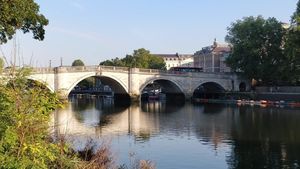
Richmond Lock and Footbridge is an intriguing blend of Victorian engineering and picturesque charm nestled in the scenic stretch of the River Thames. This handsome structure is a rare combination of lock, weir, and footbridge, showcasing the ingenuity of the late 19th century. Opened in 1894, it plays a crucial role in maintaining the river's level between Richmond and Teddington, making it navigable for boats and a delightful pathway for visitors.
Designed by the eminent 19th-century civil engineer Frederick Banister, the lock and footbridge is a testament to his vision and skill. The structure's ornate cast-iron arches and elegant lanterns are a beautiful representation of the period's design aesthetics, making it a visual treat for those interested in historical architecture.
One of the more unusual aspects of Richmond Lock is its tidal nature. Unlike most locks, Richmond operates as a half-tide or semi-tidal lock. This means that at low tide, the weir is down, and boats can pass freely, which is a rare characteristic for a lock on the Thames.
Richmond Lock and Footbridge isn't just an engineering marvel; it's also a place of quiet reflection amidst the bustling city. The footbridge offers panoramic views of the river, surrounded by lush greenery and the distant skyline of London, making it a perfect spot for a leisurely stroll or a moment of serenity.
Another interesting fact about the Richmond Lock is that it is one of the few locks in the UK that still operates manually for small boats. This traditional method adds a historical touch, allowing visitors to experience a piece of living history in operation as they watch the lockkeepers at work.
For film buffs, Richmond Lock and Footbridge may look familiar. It has served as a location for numerous films and television series over the years, adding an element of cinematic fame to its list of charms. Its classic appearance and unique setting make it a favored choice for filmmakers.
All in all, Richmond Lock and Footbridge offer a delightful mix of history, architecture, and natural beauty. Its unique features and fascinating history make it an underrated gem of London's rich tapestry of attractions, offering visitors a chance to step back in time while enjoying the scenic beauty of the river.

Making the Most of Your Visit:
Timing is everything! Visit Richmond Lock and Footbridge around low tide to experience the unique ability for boats to pass freely. It's quite a sight to see this unusual tidal operation in action.
Bring a camera or your phone for some photography because the views from the footbridge are spectacular, especially when the sun begins to set. The cast-iron arches and nearby greenery make for beautiful, frame-worthy shots.
If you're into history, take your time to appreciate the intricate details of the Victorian design. Look out for the ornate lanterns and cast-iron work, which reflect the period's stunning aesthetics.
For those interested in film, try spotting the views that have appeared in movies and TV shows. You might recognize it from a scene or two, adding a little star-studded allure to your stroll.
Finally, enjoy a peaceful moment of reflection. With the gentle flow of the Thames and lush surroundings, it's a wonderful escape from the city's hustle and bustle. It's a reminder of the simple joys that historic structures like this can offer.

Visiting Times & Costs:
Richmond Lock and Footbridge is open to the public and can be accessed throughout the year. As a public footbridge, it allows both locals and visitors to cross the River Thames and enjoy the scenic views.
There is no entrance fee to use the footbridge. It is free of charge, making it an ideal spot for a cost-effective day out.
In terms of accessibility, visitors should be aware that while the lock and footbridge are generally accessible, there are some stairs involved in accessing the footbridge, which may present difficulties for those with limited mobility or those using wheelchairs.

Address & Map:

Nearby:























